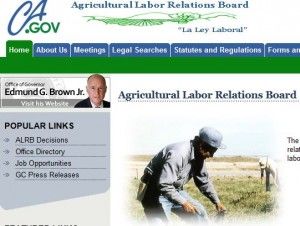What is the CA Agricultural Labor Relations Board?

 Editor’s note: This is Part 1 in a series on the ALRB.
Editor’s note: This is Part 1 in a series on the ALRB.
California government includes many boards and commissions with members appointed by the governor. Most people never get to see who these decision makers are, despite the far-reaching effects of their decisions on the people of the state.
Such is the case with the Agricultural Labor Relations Board. Made up of five members, the board was created when the Agricultural Labor Relations Act was signed into law in June 1975 by Gov. Jerry Brown.
Only 18 days later, Brown nominated the ALRB’s first five members, which the state Senate confirmed:
* Chairman Roger Mahony, at the time an auxiliary Catholic bishop for Fresno and the future cardinal and archbishop of Los Angeles. He had been involved in farm workers’ issues for many years.
* Joe Ortega, an attorney for farm workers.
* Leroy Chatfield, a former high-level UFW staffer who helped write the ALRA.
* Richard Johnson Jr., executive vice president of the California Agriculture Council.
* Joseph Grodin, a labor law professor and future California Supreme Court Justice.
According to the new 2013 book, “Trailblazer: A Biography of Jerry Brown,” by Chuck McFadden:
“The growers felt betrayed. They believed the appointments of Chatfield, Ortega and Mahony meant the board weighed 3-2 in favor of the unions. Brown himself said that he had envisioned the board as balanced, with Ortega and Chatfield representing the unions, Johnson and Grodin representing the growers, and Mahony serving as the swing vote.”
The 2008 book, “César Chávez, the Catholic Bishops, and the Farmworkers’ Struggle for Social Justice,” by Marco C. Prouty, sheds further light:
“Instead, Mahony became a lightning rod. Brown later remarked that he ‘didn’t know [Mahony] that well,’ and didn’t anticipate the bishop to be ‘as much a polarizing force as he’ was. Mahony’s ‘image in the farming community was more pro-UFW’ than Brown realized, but regardless, the governor ‘felt it was important to have a board that all sides would have some confidence in, but particularly the farm workers’….
“Mahony may have harbored a personal preference for the farmworkers, but CALRB’s records indicate that the bishop maintained his professionalism.”
An ALRB study, “Setting the Record Straight,” found that the five board members produced dissenting opinions in just 7 percent of cases.
In 1976, Mahony faced a major funding crisis for the ALRB and had to lay off workers and faced numerous other problems, as described in Prouty’s book.
Union decline
The subsequent decades have seen a reduction in the ALRB’s reason for existence, as farm unionization has declined. According to a 2000 study by Phillip Martin of University of California, Davis, “Labor Relations in California Agriculture: 1975-2000,” the ALRA was passed “to ensure peace in the agricultural fields by guaranteeing justice for all agricultural workers and stability in labor relations.” Instead, “what has happened over the past 25 years [1975-2000]: Union activities, measured by elections or unfair labor practice charges filed, peaked in 1975-76, and have since fallen over 90 percent.”
Despite passage of the ALRA in 1975, membership in unions was met with mixed results. Membership in the UFW had fallen from a high of 70,000 in 1972 to a low of 6,000 in 1974. After the ALRA’s passage, membership then rose in 1977 to only 18,000.
And at the time, Brown ally Rose Bird was his secretary of agriculture and a major author of the ALRA. She now is remembered as the first and only chief justice of the California Supreme Court to be removed from office by voters, along with associate justices Cruz Reynoso and Joseph Grodin. The latter, of course, had been one of Brown’s first appointments to the ALRB.
Current ALRB
According to the board’s website, “The agency’s authority is divided between a Board composed of five members and a General Counsel, all of whom are appointed by the Governor and subject to confirmation by the Senate.”
With two vacancies, the board currently has three members:
* Chairwoman Genevieve A. Shiroma, who has served on the board since 1999, was appointed by Gov. Gray Davis. She was reappointed by Brown in 2011.
* Cathryn Rivera-Hernandez was appointed by Davis in 2002 and re-appointed by Brown in 2013.
* Bert Mason was appointed by Davis in 1999, and served until 2002. He was appointed again by Brown in 2012.
The general counsel, Sylvia Torres-Guillén, was appointed by Brown in 2011.
Executive Secretary J. Antonio Barbosa, who runs day-to-day operations, is appointed by the board and has held his position since 1992.
This series will report on the backgrounds of the board members and officials. Part 2 of the series will be on ALRB Chairwoman Genevieve A. Shiroma.
Related Articles
CA GOP eyes asset forfeiture reform
After sailing through the state Senate, a key criminal justice reform bill with bipartisan support faced its first test in
Lies about green jobs: Now it’s the Los Angeles edition
March 1, 2013 By Chris Reed We’ve seen President Obama and Gov. Brown spread the green jobs myth, pretending that
Does Pelosi know where the most segregated U.S. cities are?
June 26, 2013 By Chris Reed The howls from California Democrats like House Speaker Nancy Pelosi were instantaneous over the



